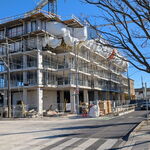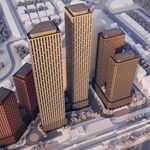TTC chief has right idea about transit priorities
BY John Barber March 2006 The Globe and Mail
LP Don't bother with the latest crossed-up smoke signals puffing out of Queen's Park. By no means attempt to pry open the black box of Transportation Minister Harinder Takhar. Ignore Mayor David Miller, whose anxious protestations that his positions are “clear†and “simple†only confirm the opposite. Desperately seeking a long-term fiscal bailout from Queen's Park, his mouth is temporarily stuffed with batting.
The one person who most needs to be heard on the (once again) promised Spadina subway extension is TTC chief general manager Rick Ducharme. Plainspoken and unafraid, Mr. Ducharme speaks for all Torontonians, especially transit users, when he lays down the law on this potentially advantageous, potentially disastrous $1.4-billion project.
TD While the mayor waffles, Mr. Ducharme presents a list of firm priorities that must be met before the commission undertakes to tunnel through the postindustrial barrens of Downsview to a grand terminus in a transmission corridor north of Steeles Avenue.
“The top priority is state-of-good-repair,†he said yesterday, repeating a phrase that has become a mantra at the TTC ever since a worn-out signalling system killed three people on the Spadina line 10 years ago. “Over the next four or five years I need about $700-million a year . . . and it's not negotiable.â€
Even though, since the change of government in Ottawa, nobody really knows where much of that money is coming from.
Then there is another $200-million a year the commission needs to advance its next priority: a new network of upgraded surface routes for buses and streetcars. None of that is budgeted yet.
“Until you get the first two phases done, the third phase — a subway — is not on the table,†Mr. Ducharme said — period, full stop, end of discussion.
In that, the TTC boss is only reciting the party line first established by his predecessor, David Gunn, who used it to pry $1-billion for maintenance out of Queen's Park before agreeing to build the unfortunate Sheppard line. What sets Mr. Ducharme apart is his post-Sheppard insistence that major real-estate development also accompany the new line.
“If you're going to build a subway from Downsview to Steeles, and you're not going to build any density around it, you're wasting your time,†the hard-headed engineer said yesterday, uttering a progressive new mantra he has been repeating to anyone who cares to listen — including provincial officials keen on getting the shovels in the ground.
“If you guys are crazy enough to support this without a signed agreement of what development there will be,†he reported himself as telling them recently, “you're not doing your job. We're civil servants, we have a job to do. I will recommend totally against that.â€
The TTC boss doesn't just want nice-sounding policies that can easily be overturned by local residents. He wants a deal, “signed up front,†that guarantees a significant amount of development around the new stations before a nickel is spent on the new subway.
“It's either up front, sign off, keep your nose out of it — or forget about it.â€
Mr. Ducharme's firm embrace of the land-use creed is a landmark in TTC thinking and the best hope for the new project. The Spadina line can work with enough density at the stations, he said, and it will also benefit the system by taking pressure off the Yonge line. “But if land-use is not tied into it, taxpayers should be concerned.â€
For all governments involved, Mr. Ducharme boils the long-standing debate about the Spadina line down to a simple choice. “You're either going to build the city and build it properly, or you're not.â€
It's that clear cut.
“Are we going to move forward in a positive way or aren't we?†he asked, repeating the question. “If not, don't expect good results.â€
jbarber@globeandmail.com
Bad teeth in a gift horse BY Royson James March 2006
The Toronto Star
LP It's been a good week for Mayor David Miller, battered and beset as he has been by the burden of a perennial budget shortfall. But the mayor may want to beware of the province bearing "gifts."
First, the Star's Ian Urquhart reported the Dalton McGuinty government has a $1 billion it has to get rid of by the end of the month. That means, no more excuses of fiscal imbalance when Toronto demands Queen's Park pay its bills - bills that threaten to sink the city into bankruptcy..
..Yesterday we heard the province is set to announce plans to take the University-Spadina subway line from its terminus at Downsview northwest to York University and beyond..
..McGuinty should reverse the destructive policies of the Harris era...
That means paying half of the TTC's $123 million annual operating subsidy..
..The demands, backed up by full-page ads and a letter-writing campaign to Toronto-area MPPs, are not as unreasonable as first thought, especially when the province is flush with cash.
Katrina Miller of the Toronto Environmental Alliance said a subway is "way, way down" the priority list, even if the subject is just public transit. The TTC needs buses, lower fares and more light rail systems.
To foist a subway on Toronto without funding the current system properly is akin to "putting an extension on the house when the roof is blowing off," the TEA's Miller said.
So, should we soon expect a new deal for transit?
"Well, let's just say that you can't have investment without operating dollars. And I would think that everybody would ask the question: Now that you've built the subway, how do you expect to run it?" said Toronto's budget chief, David Soknacki.
In other words, a deal has been struck with the province. But history tells us to be cautious.
Provincial or federal governments think short-term. The billions in gas tax money earmarked for infrastructure disappear in maintenance garages and subway cars, and McGuinty doesn't get any credit. So, there is always an urge to cut some ribbons.
Exhibit One is the proposed rapid transit line from Union Station to Pearson airport. Mississauga Mayor Hazel McCallion has slammed it as not needed. The city of Toronto has said it's not a top priority. Studies show 17 per cent of Pearson travellers end up downtown, so the line would be of limited value. Still, the federal Liberals made this line their top priority.
And although he knows better, Mayor Miller supports it because it allows him to say Toronto doesn't need an island airport for urban business travellers.
Now, the line to York University. Politics, greased by Greg Sorbara, ex- provincial treasurer, drives this. Queen's Park, not the TTC, is making the decision on a subway to York versus a subway to Scarborough versus a light rapid transit network versus a thousand new buses.
And even if the line is terrific, where are the advocates who will demand the subway go up Jane St., where masses of poor, transit-dependent people live - instead of through Downsview Park and up Keele St., where it better serves "future development?" It's possible to do the Jane St. alignment and serve York University and York region - but who hears that?
In short, the deal is already cooked. Queen's Park gets its ribbon-cutting, the city will get a little cash. And citizens? We get more questions.
-----------------------------
Not sure about James's Jane street subway alignment but do agree that it would be nice if the government operated on rational rather than political principles. Are we bound to repeat the politically motivated grand projects of the past? original Spadina to Wilson, downsview extension, SRT, Sheppard (Lastman), York subway (Sorbara), Takhar or maybe Flaherty's riding next stop?




